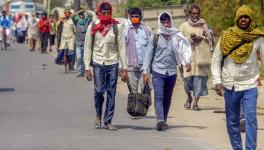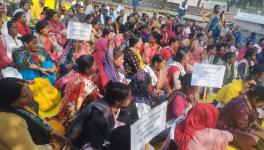Swine Flu – Extraordinary Breakdown of Public Health
The recent spate of infections and deaths, caused by the H1N1 strain of the influenza virus across many states in India has once again brought into focus India’s ailing health care system. It is unfortunate that discussions on the country’s non-functioning public health system surface only in periods when the health system is faced with a challenge.
What is Swine Flu?
Influenza caused by the H1N1 virus is also popularly called ‘swne flu’. A popular misconception is that ‘swine flu’ is spread by pigs – in fact humans and not pigs infect other humans with swine flu. Controlling the population of pigs has absolutely no effect on the spread of the disease. The term, ‘swine flu’ dates back to 2009 when the virus affected almost 20% of the global population. Tests on the genetic material of the H1N1 virus showed that it contained genetic material from viruses that cause influenza like symptoms in pigs. It has been speculated that the virus incubated and developed because of peculiar conditions that prevail in the industrial mode of animal husbandry, practiced in many countries across the world. It has now been established that the virus, in all probability, first infected human hosts in Mexico and crossed over to the United States. While the sub-type H1N1 is the dominant form of the swine flu virus, other subtypes H1N2, H1N3, H3N1, H3N2 and H2N3 are also known to cause swine flu.

Image Courtesy: wikipedia.org
Influenza – A History of Epidemics
Influenza is a disease that is caused by a number of strains of related viruses and is particularly prevalent in countries that have a severe winter – in large parts of Europe and North America, for example. There are records of influenza epidemics in the past that have caused widespread infections and deaths. The severest recorded in recent history is the ‘Spanish flu’ epidemic that raged just after the First World War. Between 1918 and 1920 the Spanish flu pandemic (i.e. an epidemic that established itself in several regions of the world) infected 500 million people across the world and killed an estimated 50 to 100 million people. Since then, though we have not encountered a pandemic that equals the severity of the Spanish flu, there have been periodic epidemics and pandemics affecting different parts of the world. The most reason pandemic was in 2009, caused by the swine flu (H1N1) virus. The World Health Organization (WHO) issued a level 6 pandemic warning in 2009 in the midst of widespread fears that it would rival the Spanish flu pandemic in terms of effects on the global population. However the 2009 pandemic proved to be much milder than anticipated. Retrospective studies now indicate that almost a quarter of the world’s population was infected by the H1N1 virus between 2009 and 2010, indicating that in terms of percentage of the world’s population infected, the 2009 pandemic was quite similar to the 1918 pandemic. Fortunately the disease was of much lower severity, and studies show that the infection led to about 2,00,000 deaths globally.
What the history of influenza epidemics and pandemics show is that there is a huge spike in the number of infections when a new variant of the influenza virus surfaces. This was the case in both the 1918 and the 2009 pandemics. As we have indicated earlier, the new variant of the virus in 2009 probably arose because of the conditions of industrial style animal husbandry, leading to the development of a new variant that incorporated genetic material from viruses that cause disease in pigs. It must be understood, however, that there is a spike (though not as pronounced as for a new variant) in the cases ‘seasonal’ influenza in particular seasons. Seasonal flu is caused by a number of existing variants of the influenza virus that are usually present in the environment. In colder climates the spike in influenza incidence usually takes place in autumn and winter, while in tropical countries such as India the spikes occur in spring and autumn. The seasonal increases in incidence of infection are related to specific climatic conditions that the influenza virus finds particularly conducive and to conditions of living that allow quick transmission of the virus.
Immune System and cyclical Influenza Incidence
Two issues, both related to the human body’s immune system, need to be understood in relation to the cyclical incidence of influenza. One bout of infection with the influenza virus confers immunity to the infected person as the body develops specific antibodies to fight against the infection. The period for which such immunity lasts is variable, depending on the person’s age and general immune status. The immunity may last for shorter periods in older people and people with an already compromised immune system (for example those suffering from serious chronic illnesses and those taking some forms of medication). The immunity is to the specific infecting influenza virus though individuals usually acquire partial immunity to other variants of the influenza virus as well. When a new viral strain starts infecting people, it is always much more infective as no one has been previously exposed to the particular virus. Over a period, as more people are infected and thus become immune for variable periods, the infection rate of the virus starts declining. Thus, both in 1918 and 2009, the number of infected people declined dramatically over two years.
The working of the immune system also explains why there are periodic spikes in seasonal influenza cases, every few years. Every season there are a number of influenza cases reported, but every 3-4 years there is a perceptible rise in cases in a particular year. This happens because when the immune levels of a large number of people starts declining, i.e. the protective effect of previous infections start waning, a larger number of people get infected in a particular season.
What we are seeing in India now is a rise in H1N1 influenza cases, as the protective effect on the population of the global pandemic of 2009 has receded. It is important to remember that seasonal influenza is caused by a number of variants of the influenza virus. It is quite likely that the H1N1 virus has become, at least in some parts of the country, the major variant that causes seasonal influenza.
Influenza symptoms vary across populations
Infection with the H1N1 virus is virtually impossible to distinguish from infections caused by other influenza viruses. Symptoms of H1N1 infection are similar to most influenza infections, and include fever (100 F or greater), cough, nasal secretions, fatigue, and headache. Some patients may also get a sore throat, rash, body aches, headaches, chills, nausea, vomiting, and diarrhea. The incubation period from exposure to first symptoms is about one to four days, with an average of two days. The symptoms last about one to two weeks and can last longer if the person has a severe infection. Those with H1N1 infection appear to be more likely to have vomiting and diarrhea and H1N1 infections seem to affect younger people more than in the case of other influenza viruses. However these differences are not pronounced enough to make it possible to distinguish between H1N1 and other forms of influenza.
There is a huge variation in the severity of symptoms in those infected. It may range from minor nasal congestion and sore throat to much more severe symptoms of high fever, cough and pneumonia. Those who exhibit severe symptoms may also contract bacterial pneumonia. Most people with pneumonia infections will have mild to moderate symptoms, requiring no specific treatment. At the peak of the H1N1 pandemic, it was estimated in Mexico that about 6% of those infected were dying – a very high figure. However by the end of 2010 the estimates had come down to just 1 in 1000 deaths in those infected (0.1%). Subsequent studies led by the World Health Organization (WHO) indicate that about 1 in 5,000 (0.02%) of those infected with the virus died during the 2009 pandemic. This is much lower than in the 1918 "Spanish flu" pandemic, which had an estimated mortality rate ranging from 2%-20%. The discrepancies in estimates in 2009 and later are explained by the fact that initial estimates were based on those who actually tested positive for H1N1. Later, it was understood, that a much larger number were infected but were never tested. This was because most has such mild symptoms that they did not seek medical device, or were not referred for specific testing for H1N1. A paper in the medical journal, the Lancet in 2014 noted that just 23% of these who were infected b H1N1 in 2009 actually exhibited symptoms and only 17% of people were ill enough to consult their doctor.
In fact the WHO has been faulted for issuing a ‘level 6’ pandemic alert in 2009 – signaling an acute emergency requiring drastic measures (and thereby contributing to widespread global panic). The WHO has been criticized for basing its perception of the pandemic on the geographic spread of the disease (which was clearly very extensive) but not accounting for the relatively mild severity of the disease.
Is this an epidemic?
It is in this above background that the current ‘swine flu’ outbreak in India needs to be viewed. Clearly there is a major outbreak of influenza in India that is currently affecting many parts of the country. As is to be expected, local conditions (climatic, health system related, etc.) are determining the spread in different states, explaining why some states are more affected than others. In epidemiological terms it is not clear whether this can be termed as an epidemic. To term a disease outbreak as an epidemic it has to be shown that the prevalence of the disease is significantly higher than in similar periods, earlier. As we have noted earlier, seasonal influenza affects all countries, including India, every year. What we are seeing today is that the H1N1 virus is now a seasonal strain and that hence it is not surprising that influenza patients are testing positive to the H1N1 strain.
The problem of terming this an epidemic is critically related to the fact that we do not have reliable population wide data regarding disease prevalence and morbidity and mortality related to different diseases. Because we do not have the data we do not know if infection rates and deaths are significantly higher than in ‘normal’ seasons. It could just be a one season spike in cases, as is to be expected because the immune protection of the 2009 pandemic has receded. Thus for example, if we only go by the number of reported deaths, then it would not be seen as an epidemic in the US – where an average of 36,000 deaths is related to influenza every year. In India, we simply don’t know the average number of deaths caused by influenza.
However, because we do not have population wide disease surveillance data, many questions remain unanswered. We don’t know if the majority of the flu cases are being caused by the H1N1 virus. We don’t know if the number of cases are significantly higher this season, nor whether a relatively higher percentage of the infected run the risk of severe symptoms. We don’t know if the H1N1 strain has mutated and become more virulent. Because we don’t know, even people at the highest levels of governance are content to speculate and spread disinformation. Recently the Chief Minister of Bengal is believed to have stated that the government would control the swine population in the state to counter the outbreak. Such statements are an example of the ignorance about public health that pervades the highest levels of the administration and government.
Broken Public Health Response
The important discussion is not whether this is an epidemic but what the public health response to seasonal influenza should be. Influenza, in an overwhelming majority of patients, is not life threatening and even benign. However a very small fraction of patients develop severe respiratory symptoms and need respiratory support (such as a ventilator to help the patient breathe). The absolute number of such patients during seasonal influenza can be quite large as a very large proportion of the population gets infected. Patients can get pneumonia through bacterial secondary infection if the viral infection persists, and some can develop seizures. Death often occurs from secondary bacterial infection of the lungs and appropriate antibiotics need to be used in these patients. The role of a public health system is to be able to detect those who are at risk of developing more severe symptoms and to monitor and treat them appropriately. Unfortunately, many patients who are dying could have been saved. They are dying because either the public health system does not have adequate facilities or these facilities are clustered in big cities and hence largely inaccessible to most patients.
As a result private facilities are fleecing vulnerable populations by charging enormous amounts for testing, for prescribing anti-flu drugs and expensive antibiotics and for providing vaccines. Routine testing of all flu patients serves no purpose as most of them will not require specific treatment. Even when they test positive from H1N1, specific anti-viral therapy with drugs (three drugs are now available: oseltamivir – sold as Tamiflu, zanamivir and peramivir) is only recommended in severe cases. Further the drugs are not a cure, act best only if started within 48 hours of the onset of disease, and generally act to shorten the duration of symptoms by an average of 24 hours. Private hospitals are also enticing people to get vaccinated, though vaccination is only recommended for high risk patients (those suffering from serious existing illnesses, health workers and contacts of patients with severe illness).
What is frightening about the H1N1 outbreak is not that it is an epidemic which will cause hundreds of thousands of deaths. In all probability it will die down on its own when summer sets in, as all seasonal influenza outbreaks do. What is frightening is that the country’s health system is not in the least prepared to deal with an influenza epidemic, which doesn’t appear to be more severe than most seasonal flu outbreaks. The Government would be happy to dub this as an epidemic, and somehow to then give the idea that it is struggling against odds to provide care under extraordinary circumstances. This is not an extraordinary outbreak, but an extraordinary breakdown of routine public health services.
Disclaimer: The views expressed here are the author's personal views, and do not necessarily represent the views of Newsclick
Get the latest reports & analysis with people's perspective on Protests, movements & deep analytical videos, discussions of the current affairs in your Telegram app. Subscribe to NewsClick's Telegram channel & get Real-Time updates on stories, as they get published on our website.
























